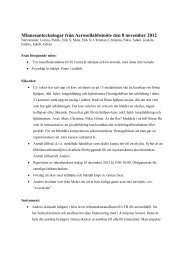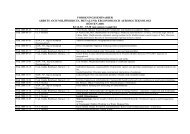ESTIMATING CLOUD DROPLET EFFECTIVE RADIUS ... - CAST
ESTIMATING CLOUD DROPLET EFFECTIVE RADIUS ... - CAST
ESTIMATING CLOUD DROPLET EFFECTIVE RADIUS ... - CAST
- No tags were found...
You also want an ePaper? Increase the reach of your titles
YUMPU automatically turns print PDFs into web optimized ePapers that Google loves.
<strong>ESTIMATING</strong> <strong>CLOUD</strong> <strong>DROPLET</strong> <strong>EFFECTIVE</strong> <strong>RADIUS</strong> FROM SATELLITE REFLECTANCE DATAModified Exponential Approximation___________________________________________________________________________________________________1 INTRODUCTION1.1 BackgroundOne of the major uncertainties in the models used for creating projections of future climate isthe indirect effect of aerosols on global warming. In masses of air with high moisture content,aerosols may act as condensation nuclei and trigger the forming of cloud droplets, having anoverall cooling effect on the global climate (IPCC, 2007). A high concentration of aerosolsincreases the number of cloud condensation nuclei (CCN) and thus generating more, butsmaller cloud droplets. Hence aerosols affect cloud droplet size, optical thickness, growth rateand life time of clouds to name a few parameters. When it comes to anthropogenic aerosols,often produced close to the ground by industrial and engine combustion, the influence onconvective clouds such as cumulus clouds is believed to be significant, since these cloudtypes are fed by air masses rising from below.Studying the indirect effect of aerosols involves modelling cloud dynamics and cloudstructures. However, cloud modelling is a complex issue, since clouds are seldom, if everhomogeneous. A cloud cannot be considered as a single entity, but rather as a composition ofbillions of much smaller units, cloud droplets. The drop size distribution varies with heightand the phase may change from water to mixed phase to ice through the vertical profile of thecloud giving rise to different radiative characteristics. Since many satellites provide data ofphysical parameters such as reflectivity and emissivity at several wavelengths, covering mostparts of the world with frequent time intervals, satellite observations is a valuable source ofinformation. Through the development of technology and computer power, which has enabledmanaging large amounts of data and faster computations, satellite measurements have becomeextensively used in cloud and atmospheric research in the last decades.Numerous studies with focus on radiative characteristics of clouds have been performed, butbecause of the complexity of cloud modelling most algorithms are developed for planeparallel clouds, such as stratus clouds. The basic principle in the technique of using multispectralreflectance data for determining microphysical properties in clouds, such as opticalthickness and droplet sizes, is the variations in reflectance due to these two parameters atdifferent wavelengths. In the visible region the reflection function is primarily a function ofcloud optical thickness, while in the near or mid infrared the reflection function dependsprimarily on cloud droplet sizes (Nakajima and King, 1990; Liou, 1992; Kokhanovsky, 2006).1.2 AimIn this study the cloud effective radius of cumulus (water) clouds over southern Sweden ismodelled from satellite data. When modelling cloud droplet sizes the effective radius ispreferable to mode or mean radius since it better accounts for the size distribution within thecloud. The effective radius is defined as follows:∞∫∞∫32r e= r n( r)dr r n(r)dr(1.1)00where n(r) is the particle size distribution and r is the particle radius (Rosenfeld and Lensky,1998; Nakajima and King, 1990).3




